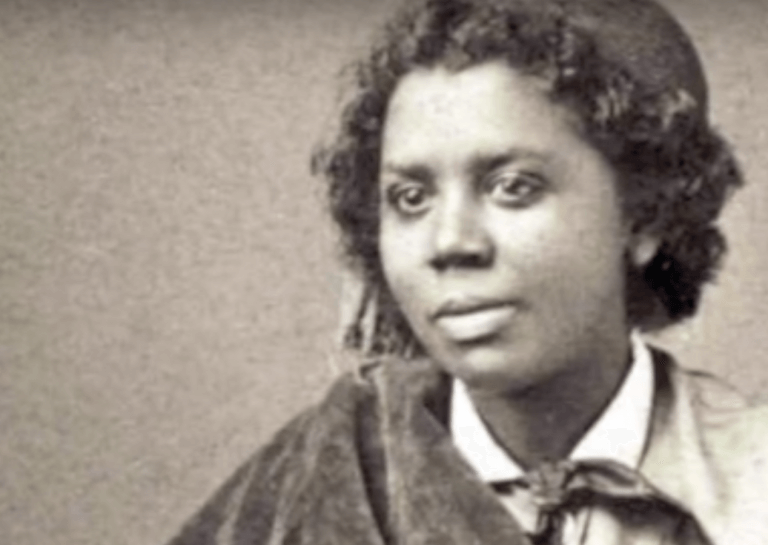Mary Edmonia Lewis was a pioneering American sculptor who worked most of her career in Rome, Italy.
Born in New York, Edmonia Lewis was the first African-American woman to achieve international fame and was also the first African-American to gain recognition as a sculptor in the world of fine arts.
- Many American artists of the 19th and 20th centuries have enjoyed fame in their own country.
- Yet Edmonia Lewis is one of the few exceptions.
He knows his life and work, how he managed to overcome the obstacles that society imposed on him, break molds and, against all odds, gain worldwide recognition.
Edmonia Lewis was born a free black woman around 1844 in Greenbush, New York. He had a brother who, as an adult, was financially successful thanks to gold mining.
Little Edmonia was the daughter of a black man, a servant of a lord. His mother, also black, had ancestors of Ojibwa and Africans. The Ojibwa are one of the largest indigenous peoples in North America, along with the Cherokee and Navajo.
Edmonia was orphaned at the age of ten and, as she later said, was raised by members of the Ojibwa family near Niagara Falls.
Mary Edmonia Lewis had little education, however, with the support of an older brother, she attended Oberlin College in Ohio, where she studied from 1860 to 1863, emerging as a talented artist.
At the time, the abolitionist movement was active on the Oberlin campus and had a major impact on Edmonia’s later artistic career.
The young woman had to overcome many obstacles to become a respected artist and at Oberlin College was falsely accused of trying to poison two white colleagues.
As a result, she was captured and beaten by a white mob; however, Lewis recovered from the attack and moved to Boston after dropped the charges against him.
In Boston, Lewis befriended abolitionist William Lloyd Garrison and sculptor Edward A. Brackett. It was Brackett who taught Lewis sculpture and helped her set up her own studio.
In the early 1860s, Lewis began to be recognized for his work, which had an impact on the art world. His clay and plaster medallions, representing Garrison, John Brown and other abolitionist leaders, opened a small door to commercial success.
In 1864 Lewis created a bust of Colonel Robert Shaw, hero of the Civil War who died at the head of the 54th Massachusetts Regiment. Thanks to this work, he achieved his first considerable commercial success.
The money he earned after selling copies of the bust allowed him to move to Rome Why move to the Italian city?
By then, Rome had become home to several expatriate American artists, including several women who had come to the city in search of an opportunity.
In Italy, Lewis continued to work as an artist. His work focused on an issue related to his African-American cultural heritage and, secondly, to his religion, Catholicism.
One of his most acclaimed works was “Always Free?(1867), sculpture of a black man and woman coming out of slavery. In addition, Lewis also sculpted busts for U. S. presidents, including Ulysses S. Grant and Abraham Lincoln.
Another example of connecting to your inheritance is seen in?The arrow maker? (1866), a work inspired by his Aboriginal roots, which shows a father teaching his daughter to make an arrow.
One of his most famous works was a depiction of Egyptian Queen Cleopatra, entitled “The Death of Cleopatra”. He received critical recognition during his presentation at the Philadelphia Exhibition in 1876 and chicago two years later.
The two-ton sculpture never returned to Italy because Lewis could not afford the exorbitant costs of its expedition, yet it was stored and rediscovered several decades after his death.
As in his childhood, Edmona Lewis’ later years are shrouded in mystery and he is known to have continued to exhibit his work until the late 1890s.
In addition, he was visited by Frederick Douglass in Rome and never married or had children; however, there is little data on his last decade of life.
Lewis is believed to have spent his final years in Rome, but despite this, some documents have recently been discovered indicating that he died in London in 1907.
Despite her status as a black woman and woman, she managed to receive applause for her work in life. However, true recognition would come after his death, when the art world finally surrendered to his magnificent work.
In the late 20th century, Lewis’s life and art received posthumous praise and his work appeared in various exhibitions.
Some of his most famous pieces today are in the permanent collections of the Smithsonian Museum of American Art and the Metropolitan Museum of Art.
Samples were also found at the Cleveland Museum of Art and Howard University Art Gallery, so you can appreciate, applaud and finally recognize the legacy of pioneering Edmonia Lewis.

